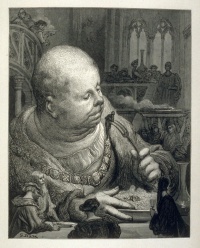Grotesque body
From The Art and Popular Culture Encyclopedia
|
Related e |
|
Featured: |
The grotesque body (also called lower bodily stratum or lower stratum) is a concept, or literary trope -- a combination of the corporeality of the human body and the notion of the grotesque -- first put forward by Russian literary critic Mikhail Bakhtin who defined it in his study Rabelais and His World (1965) as:
- "the three main acts in the life of the grotesque body: sexual intercourse, death throes (in their comic presentation— hanging tongue, expressionless popping eyes, suffocation, death rattle) and the act of birth." (p. 353, tr. Helene Iswolsky)
And in another, longer passage:
- "Contrary to modern canons, the grotesque body is not separated from the rest of the world. It is not a closed, completed unit; it is unfinished, outgrows itself, transgresses its own limits. The stress is laid on those parts of the body that are open to the outside world, that is, the parts through which the world enters the body or emerges from it, or through which the body itself goes out to meet the world. This means that the emphasis is on the apertures or convexities, or on various ramifications and offshoots: the open mouth, the genital organs, the breasts, the phallus, the potbelly, the nose. The body discloses its essence as a principle of growth which exceeds its own limits only in copulation, pregnancy, childbirth, the throes of death, eating, drinking, or defecation. This is the ever unfinished, ever creating body, the link in the chain of genetic development, or more correctly speaking, two links shown at the point where they enter into each other. This especially strikes the eye in archaic grotesque". (p. 26, tr. Helene Iswolsky)
Bakhtin explained how the grotesque body is a celebration of the cycle of life: the grotesque body is a comic figure of profound ambivalence: its positive meaning is linked to birth and renewal and its negative meaning is linked to death and decay. In Rabelais' epoch (1500–1800) "it was appropriate to ridicule the king and clergy, to use dung and urine to degrade; this was not to just mock, it was to unleash what Bakhtin saw as the people’s power, to renew and regenerate the entire social system. It was the power of the people’s festive-carnival, a way to turn the official spectacle inside-out and upside down, just for a while; long enough to make an impression on the participating official stratum. With the advent of modernity (science, technology, industrial revolution), the mechanistic overtook the organic, and the officialdom no longer came to join in festive-carnival. The bodily lower stratum of humor dualized from the upper stratum."
Legacy
The concept is still in use in the late 20th and early 21st centuries, in such works as Subversive Pleasures: Bakhtin, Cultural Criticism, and Film by Robert Stam.
Interpretation
In the words of Philip Thomson:
- For Bakhtin-and one finds it difficult to disagree with him-the grotesque is essentially physical, referring always to the body and bodily excesses and celebrating these in an uninhibited, outrageous but essentially joyous fashion. The carnival, that favourite popular arena for the indulging of physical excess, is seen by Bakhtin as the grotesque event par excellence, the place where the common people abandoned themselves to exuberantly obscene excesses of a physical kind. One can see a whole popular tradition of the grotesque here, ranging from the ancient satyr-plays to the commedia dell'arte (cf. Jacques Callot's marvellously grotesque illustrations of commedia dell'arte characters and scenes), with important links with dramatists as far apart as Aristophanes and the 'pataphysicist' Alfred Jarry, creator of the monstrously grotesque Ubu figure. It might be objected that Bakhtin's view of the grotesque is idiosyncratic and narrow (he develops it principally in connection with Rabelais, to whom it applies very well), but his insistence on the physical nature of the grotesque and on the primitive delight in what is obscene, cruel and even barbaric is quite justified. We would only wish to add that this delight constitutes only one possible aspect of the response to the grotesque. (The Grotesque. Methuen Critical Idiom Series, 1972, p 56.)
See also
- Body genres
- Body politics
- Carnival
- Carnivalesque
- Corporeality in Montaigne
- Embodied cognition
- Genre theory
- Grotesque
- Heteroglossia
- Human body
- Ribaldry, scatology, toilet humour, vulgarism
- Materialism
- Profanity, obscenity, decency, taste (sociology), aesthetic relativism
- Commedia dell'arte, burlesque, vaudeville
- Plautus' Amphitruo
- Trickster


.png)

